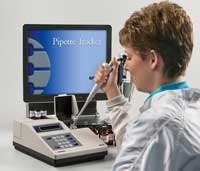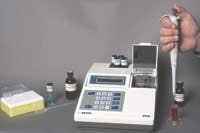By Trena M. Penney
Quenching the thirst of Americans, drinking more than one billion glasses of tap water each day, is not an easy task. Water quality laboratories must analyze water samples for a variety of harmful substances. Any errors in testing can result in the release of contaminated water to the public. Therefore, water quality laboratories are tightly regulated by federal and state authorities.
Statutes and regulations mandate that quality control be performed regularly using a recognized method for all critical laboratory processes, and this includes pipette calibration. Pipettes are essential in water testing processes and are used to conduct a variety of volume–dependent contaminant identification tests. To ensure accurate results, water quality laboratories must implement measures to verify the accuracy and precision of their liquid delivery instruments.
Ratiometric Photometry allows for accurate and consistent testing of pipettes and pipetting technique. An advanced calibration methodology measuring the light absorbance of two dyes to verify volume, Ratiometric Photometry has been recognized by the International Organization for Standardization (ISO). Water testing laboratories can use this bench–top technology to assure that their equipment and processes are within standards.
Sampling, Testing
To ensure effective water treatment, robust sampling and testing processes are employed at water quality laboratories nationwide, with samples taken from a large number of sampling points for analysis. For example, in 2005 New York State extracted 33,200 samples from over 100 sampling points. Once delivered to water quality laboratories, these samples undergo analyses for toxic substances. The quality of the public’s drinking water therefore relies on the quality of laboratory testing procedures. Since tests for unacceptable levels of chemical and biological contaminants are highly volume dependent, pipettes are a critical component in the process.
Given the criticality of liquid handling quality assurance, accuracy, precision and efficiency are necessary characteristics of the selected pipette calibration technology. Using a balance to weigh liquid quantities for volume verification, gravimetric calibration is one method. However, gravimetry can be time consuming and is affected by environmental conditions such as humidity, air flow and temperature.
For this reason, several water quality laboratories have chosen Ratiometric Photometry as their liquid handling quality assurance method in order to produce volume verifications that are quicker, more accurate and immune to environmental conditions. Also, the technology can verify minute volumes with a high degree of accuracy, while providing automated verification and documentation of calibration results to meet federal and state water quality testing standards.
For example, calibration systems based on Ratiometric Photometry can perform a 10–point calibration in three to four minutes, as compared to gravimetric methods requiring 15 to 60 minutes. This time–saving encourages more frequent pipette calibration (sometimes called interim verification or functional checks), and therefore helps ensure more consistent and reliable pipetting.
No Room for Error
The need for a rigorous calibration process at water quality laboratories is due to the large role that pipettes play in testing for the nearly 100 substances identified as toxic, ranging from microbiological contaminants and metal to radiological constituents, bacteria, viruses and protozoans. A large majority of these tests are highly volume–dependent, requiring the addition of specified volumes of sample and reagents for accurate analysis.
Volume is critical in microbiology tests, for example, because each volume addition has a specified number of bacteria colonies present, and altering this quantity can affect test results.
Consider the impact of using an under–delivering pipette to conduct a test for cryptosporidium or giardia, two potentially lethal microbiological contaminants. If the original dispense volume is just two or three microliters below its target, the results could show the contaminant level to be two or three micrograms less than its actual presence. The sample could be cleared as fit for human consumption when in fact the contaminant level exceeds the maximum permitted by the Environmental Protection Agency (EPA).
Another water quality laboratory process affected by pipetting error is the addition of preservatives to samples, which is required for tests for certain contaminants that break down readily. Adding an inaccurate quantity of preservatives could lead to premature contaminant breakdown and a failure to identify a harmful presence.
Accuracy in pipetting is very important, and this depends not only on the instruments’ mechanical function but also proper pipetting technique. A regular calibration program can minimize the risk of using malfunctioning pipettes in critical tests by quickly identifying pipettes operating outside specified tolerances. Yet pipetting technique can also affect delivered volume, and operator training is necessary.
Pipette technique training can help technicians hone their pipetting skills for greater accuracy and precision. Ratiometric Photometric calibration systems immediately produce volume verification, providing users with instant verification of proper pipetting technique and ongoing training.
About the Author
Trena M. Penney is Technical Marketing Representative at ARTEL, providing liquid delivery process support for the customers in pharmaceutical and biotechnology laboratories. Penney has received awards from the American Society of Microbiology for research regarding the prevalence and detection of E. coli. ARTEL is a worldwide provider of equipment for low–volume liquid delivery measurement and quality assurance. Website: www.artel–usa.com





